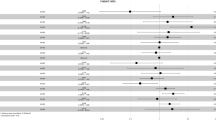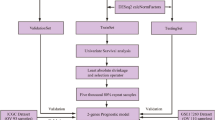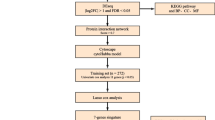Abstract
Ovarian cancer is the worst gynecological malignancy around the globe because of its asymptomatic existence. Due to the lack of diagnostic strategies in ovarian cancer, it is being detected at an advanced stage. It will continue to rise in the future as well because of the rapidly aging population and lifestyle. At the individual level, the financial burden is relatively high. Currently, there is no remedy for disease treatment and the perfect way to reduce its morbidity and incidence is to detect it early. In clinical trials, the advancement in molecular biology, bioinformatics, and laboratory technology have broadened the use and feasibility of applying biomarkers in disease treatment. Amidst all these, the applications of Gene expression signatures (GES) have shown to be a powerful tool. GES are dominant tools that can unfold a spectrum of biologically and clinically relevant aspects of biological samples. Over the past few years differentiation has been made in different subtypes of tumors with the help of gene expression signatures. It also helps in predicting clinical outcomes in cancer and model the signaling pathways activation. During the past two decades, gene signatures detection from genomic data has always been an important topic of discussion in the medical field. This chapter deals with gene expression signature and its role in complex diseases. Further, we also describe the prognostic relevance of gene expression signature in ovarian cancer.
Access this chapter
Tax calculation will be finalised at checkout
Purchases are for personal use only
Similar content being viewed by others
References
Ghafouri-Fard, S., Shoorei, H., & Taheri, M. (2020). miRNA profile in ovarian cancer. Experimental and Molecular Pathology, 113, 104381.
Biamonte, F., et al. (2019). MicroRNA let-7g acts as tumor suppressor and predictive biomarker for chemoresistance in human epithelial ovarian cancer. Scientific Reports, 9(1), 1–12.
Dwivedi, S. K. D., et al. (2021). Small non-coding-RNA in gynecological malignancies. Cancers, 13(5), 1085.
Devouassoux-Shisheboran, M., & Genestie, C. (2015). Pathobiology of ovarian carcinomas. Chinese Journal of Cancer, 34(1), 50–55.
Labidi-Galy, S. I., et al. (2017). High grade serous ovarian carcinomas originate in the fallopian tube. Nature Communications, 8(1), 1–11.
Dochez, V., et al. (2019). Biomarkers and algorithms for diagnosis of ovarian cancer: CA125, HE4, RMI and ROMA, a review. Journal of Ovarian Research, 12(1), 1–9.
Hellström, I., et al. (2003). The HE4 (WFDC2) protein is a biomarker for ovarian carcinoma. Cancer Research, 63(13), 3695–3700.
Brachova, P., et al. (2015). TP53 oncomorphic mutations predict resistance to platinum-and taxane-based standard chemotherapy in patients diagnosed with advanced serous ovarian carcinoma. International Journal of Oncology, 46(2), 607–618.
Bodnar, L., et al. (2014). Wnt/β-catenin pathway as a potential prognostic and predictive marker in patients with advanced ovarian cancer. Journal of Ovarian Research, 7(1), 1–10.
Steinberga, I., Jansson, K., Sorbe, B. (2019). Quality indicators and survival outcome in stage IIIB-IVB epithelial ovarian Cancer treated at a single institution. In vivo, 33(5), 1521–1530.
Goff, B. A., et al. (2004). Frequency of symptoms of ovarian cancer in women presenting to primary care clinics. JAMA, 291(22), 2705–2712.
Lheureux, S., et al. (2019). Epithelial ovarian cancer. The Lancet, 393(10177), 1240–1253.
Edge, S., et al. (2010). American Joint Committee on Cancer cancer staging manual. Annals of Surgical Oncology, 17, 1471–1474.
Prat, J., & F. C. o. G. (2014). Oncology, staging classification for cancer of the ovary, fallopian tube, and peritoneum. International Journal of Gynecology & Obstetrics, 124(1), 1–5.
Hora, S., Pandey, A. K., Jha, S. (2018). Biomarker-based targeted therapeutics. Neoplasm, 159.
Goossens, N., et al. (2015). Cancer biomarker discovery and validation. Translational Cancer Research, 4(3), 256.
Raposo, G., & Stoorvogel, W. (2013). Extracellular vesicles: Exosomes, microvesicles, and friends. Journal of Cell Biology, 200(4), 373–383.
Van Doormaal, F., et al. (2009). Cell-derived microvesicles and cancer. The Netherlands Journal of Medicine, 67(7), 266–273.
Valadi, H., et al. (2007). Exosome-mediated transfer of mRNAs and microRNAs is a novel mechanism of genetic exchange between cells. Nature Cell Biology, 9(6), 654–659.
Taylor, D. D., & Gercel-Taylor, C. (2008). MicroRNA signatures of tumor-derived exosomes as diagnostic biomarkers of ovarian cancer. Gynecologic Oncology, 110(1), 13–21.
Peinado, H., et al. (2012). Melanoma exosomes educate bone marrow progenitor cells toward a pro-metastatic phenotype through MET. Nature Medicine, 18(6), 883–891.
Ciravolo, V., et al. (2012). Potential role of HER2-overexpressing exosomes in countering trastuzumab-based therapy. Journal of Cellular Physiology, 227(2), 658–667.
Sithara, S., et al. (2017). Gene expression signature: A powerful approach for drug discovery in diabetes. Journal of Endocrinology, 232(2), R131–R139.
Bevilacqua, J. L. B., et al. (2007). Doctor, what are my chances of having a positive sentinel node? A validated nomogram for risk estimation. Journal of Clinical Oncology, 25(24), 3670–3679.
Venet, D., Dumont, J. E., & Detours, V. (2011). Most random gene expression signatures are significantly associated with breast cancer outcome. PLoS Computational Biology, 7(10), e1002240.
Kalia, M. (2013). Personalized oncology: Recent advances and future challenges. Metabolism, 62, S11–S14.
Jabeen, A., Ahmad, N., & Raza, K. (2019). Differential expression analysis of ZIKV infected human RNA sequence reveals potential genetic biomarkers. In Lecture notes in bioinformatics 2019 (Vol. 11465, pp. 1–12). Springer.
Zhang, Y., Qazi, S., & Raza, K. (2021). Differential expression analysis in Ovarian Cancer: A functional genomics and systems biology approach. Saudi Journal of Biological Sciences, 28(7), 4069–4081.
Konecny, G. E., Winterhoff, B., & Wang, C. (2016). Gene-expression signatures in ovarian cancer: Promise and challenges for patient stratification. Gynecologic Oncology, 141(2), 379–385.
Guo, L., et al. (2017). Expression profiles analysis reveals an integrated miRNA-lncRNA signature to predict survival in ovarian cancer patients with wild-type BRCA1/2. Oncotarget, 8(40), 68483.
Wang, L., et al. (2017). Identification of long non-coding RNA signature for paclitaxel-resistant patients with advanced ovarian cancer. Oncotarget, 8(38), 64191.
Liu, R., et al. (2017). Long noncoding RNA expression signature to predict platinum-based chemotherapeutic sensitivity of ovarian cancer patients. Scientific Reports, 7(1), 1–10.
Berchuck, A., et al. (2005). Patterns of gene expression that characterize long-term survival in advanced stage serous ovarian cancers. Clinical Cancer Research, 11(10), 3686–3696.
Denkert, C., et al. (2009). A prognostic gene expression index in ovarian cancer—Validation across different independent data sets. The Journal of Pathology: A Journal of the Pathological Society of Great Britain and Ireland, 218(2), 273–280.
Jochumsen, K. M., et al. (2009). Gene expression profiles as prognostic markers in women with ovarian cancer. International Journal of Gynecologic Cancer, 19(7).
Konstantinopoulos, P. A., et al. (2010). Gene expression profile of BRCAness that correlates with responsiveness to chemotherapy and with outcome in patients with epithelial ovarian cancer. Journal of Clinical Oncology, 28(22), 3555.
Spentzos, D., et al. (2004). Gene expression signature with independent prognostic significance in epithelial ovarian cancer. Journal of Clinical Oncology, 22(23), 4700–4710.
Konecny, G. E., et al. (2014). Prognostic and therapeutic relevance of molecular subtypes in high-grade serous ovarian cancer. JNCI: Journal of the National Cancer Institute, 106(10).
Karlan, B. Y., et al. (2014). POSTN/TGFBI-associated stromal signature predicts poor prognosis in serous epithelial ovarian cancer. Gynecologic Oncology, 132(2), 334–342.
Yoshihara, K., et al. (2012). High-risk ovarian cancer based on 126-gene expression signature is uniquely characterized by downregulation of the antigen presentation pathway. Clinical Cancer Research, 18(5), 1374–1385.
Yoshihara, K., et al. (2010). Gene expression profile for predicting survival in advanced-stage serous ovarian cancer across two independent datasets. PloS One, 5(3), e9615.
Jazaeri, A. A., et al. (2005). Gene expression profiles associated with response to chemotherapy in epithelial ovarian cancers. Clinical Cancer Research, 11(17), 6300–6310.
Hartmann, L. C., et al. (2005). Gene expression profiles predict early relapse in ovarian cancer after platinum-paclitaxel chemotherapy. Clinical Cancer Research, 11(6), 2149–2155.
Kang, J., D’Andrea, A. D., & Kozono, D. (2012). A DNA repair pathway–focused score for prediction of outcomes in ovarian cancer treated with platinum-based chemotherapy. Journal of the National Cancer Institute, 104(9), 670–681.
Verhaak, R.G., et al. (2012). Prognostically relevant gene signatures of high-grade serous ovarian carcinoma. The Journal of clinical investigation, 123(1).
Network, C. G. A. R. (2011). Integrated genomic analyses of ovarian carcinoma. Nature, 474(7353), 609.
Tothill, R. W., et al. (2008). Novel molecular subtypes of serous and endometrioid ovarian cancer linked to clinical outcome. Clinical Cancer Research, 14(16), 5198–5208.
Schena, M., et al. (1995). Quantitative monitoring of gene expression patterns with a complementary DNA microarray. Science, 270(5235), 467–470.
Golub, T. R., et al. (1999). Molecular classification of cancer: Class discovery and class prediction by gene expression monitoring. Science, 286(5439), 531–537.
Van De Vijver, M. J., et al. (2002). A gene-expression signature as a predictor of survival in breast cancer. New England Journal of Medicine, 347(25), 1999–2009.
Qian, Y., et al. (2021). Prognostic cancer gene expression signatures: Current status and challenges. Cells, 10(3), 648.
Cardoso, F., et al. (2016). 70-gene signature as an aid to treatment decisions in early-stage breast cancer. New England Journal of Medicine, 375(8), 717–729.
Ye, Q.-H., et al. (2003). Predicting hepatitis B virus–positive metastatic hepatocellular carcinomas using gene expression profiling and supervised machine learning. Nature medicine, 9(4), 416–423.
Bullinger, L., et al. (2004). Use of gene-expression profiling to identify prognostic subclasses in adult acute myeloid leukemia. New England Journal of Medicine, 350(16), 1605–1616.
Lossos, I. S., et al. (2004). Prediction of survival in diffuse large-B-cell lymphoma based on the expression of six genes. New England Journal of Medicine, 350(18), 1828–1837.
Bleicher, K. H., et al. (2003). Hit and lead generation: Beyond high-throughput screening. Nature reviews Drug discovery, 2(5), 369–378.
Evans, W. E., & Guy, R. K. (2004). Gene expression as a drug discovery tool. Nature Genetics, 36(3), 214–215.
Beg, A., & Parveen, R. (2021). Role of bioinformatics in cancer research and drug development. Translational bioinformatics in healthcare and medicine (pp. 141–148). Elsevier.
Beg, A., et al. (2019). High throughput screening, docking, and molecular dynamics studies to identify potential inhibitors of human calcium/calmodulin-dependent protein kinase IV. Journal of Biomolecular Structure and Dynamics, 37(8), 2179–2192.
Acknowledgements
The authors are thankful for the high computing infrastructure in the Department of Computer Science, Jamia Millia Islamia, New Delhi. Anam Beg is also thankful for the award of Senior Research Fellowship from the Indian Council of Medical Research (ICMR). This work is supported by the Indian Council of Medical Research.
Funding
This work was supported by the Indian Council of Medical Research (ICMR); PROJECT ID: 2019-4178.
Author information
Authors and Affiliations
Editor information
Editors and Affiliations
Rights and permissions
Copyright information
© 2022 The Author(s), under exclusive license to Springer Nature Singapore Pte Ltd.
About this chapter
Cite this chapter
Beg, A., Parveen, R. (2022). Gene Expression Signature: An Influential Access to Drug Discovery in Ovarian Cancer. In: Raza, K. (eds) Computational Intelligence in Oncology. Studies in Computational Intelligence, vol 1016. Springer, Singapore. https://doi.org/10.1007/978-981-16-9221-5_16
Download citation
DOI: https://doi.org/10.1007/978-981-16-9221-5_16
Published:
Publisher Name: Springer, Singapore
Print ISBN: 978-981-16-9220-8
Online ISBN: 978-981-16-9221-5
eBook Packages: Intelligent Technologies and RoboticsIntelligent Technologies and Robotics (R0)




